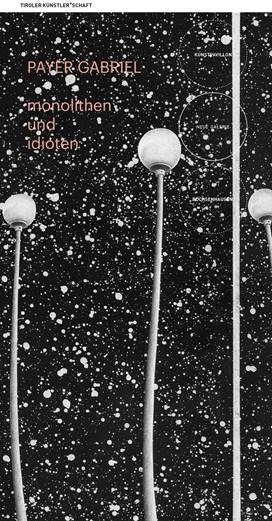monolithen und idioten
PAYER, GABRIEL

“Our existence and the world in which we live are characterized by complexity. All living things operate on a thin line between chaos and order. They follow specific ordering principles and rules, which define and control us in a huge variety of ways, from nature’s construction plan to the codes of cultural behaviour. We are interested in how complexity is manifest aesthetically.” (PAYER GABRIEL)
Micha Payer and Martin Gabriel work primarily in the medium of drawing. In jointly developed pictorial worlds they engage with various interdisciplinary questions. Orders are fathomed, and possibilities and varieties of repetition are sought in a form-finding process. Duplication and variation are applied as formal elements.
In the exhibition monoliths and idiots pillars are expanded in a model, conceptional way into the starting points for a consideration of complexity and its aesthetic presentability.
Repetition and seriality are the key elements of every complex occurrence. The complexities of individual cases as well as patterns, duplications and reflections stimulate the investigation of both form and content.
The 11 pillars distributed throughout the gallery rooms consist of square-molded steel pipes with a profile of 2×2 cm, clamped between the floor and ceiling – per pillar there are 4 molded steel pipes at intervals of 21 cm. The pillars create a spatial pattern and disclose a large number of referential systems, inasmuch as they are charged with meaning in diverse ways. Totem poles and antennae, obelisks and plague columns are objects of invocation, and projection surfaces turned towards the sky and, in an extended sense, towards the cosmos. Monoliths and idiots are averted pillars, which stand alone. Above all, the word idiot interests Micha Payer and Martin Gabriel etymologically – in antiquity, an idiot was a private individual, who did not participate by his own choice in public-political life – and also philosophically, in the sense of a person with a peculiarity, an idiosyncrasy. Playing the idiot means thinking in a totally different way, or making a new start in thought. The idiot stands outside of a society’s pressure to conform. As a term, it is value-free and stands alone, rather like a pillar.
207 drawings in A4 format from the series In Defence of the Accidental are set out in a modular way, with spaces; divided up according to perspective, together with 47 mirrors, to fragments of pillars. The title In Defence of the Accidental refers to a piece of writing of the same name[1] by German philosopher Odo Marquard, in which he defends accident as an absolute aspect of humanity, and champions diversity.
The mainly several-part drawings and mirrors are mounted quasi as modules on the freestanding pillars. In the gallery’s rearmost room, the display system culminates in the meteorite, comprising 100 drawings. Here, the interchangeable is an essential element. The artist couple works continually on this series of drawings, which is defined by a method of operation between the contingent and the conceptual. The idea of scientific and popular scientific boards and their free play with this is another important aspect.
In the Neue Galerie PAYER GABRIEL are showing core samples as horizontal antagonists to the pillars outlined by molded tubes. It is also possible to find repetition and seriality in their different patterns, colours and structures.
Positioned in the entrance area there are four half-shell core samples from the Mondsee, a lake in Salzburg (loan from Prof. Michael Strasser, Institute of Geology, University of Innsbruck). Core samples make different geological phases visible. Eras are visualized in them in the form of layers, so giving the possiblity to generate a chronology for specific events. Core samples thus permit a look into the past and indicate the directionality of time. We human beings are situated, so to speak, on the topmost layer, the surface, which represents a merely transitional phase in the history of the earth.
Hanging above the half-shell core samples is Double #7, a granulate drawing comprising two parts. Working with remains, with things that have been left over or refuse, plays an important part in the two artists’ creative investigations. Sharpener remnants left over from the drawing process are collected and kept. In reference to their investigation through drawing, these remains then flow into new works, which are understood as separate from the medium of drawing, as lettering-relief collages – like shadows with lives of their own.
Core samples from the exploration shaft of the Brenner base tunnel in Innsbruck (loan BBT SE) are placed in the wooden boxes customarily used for storage, on low steel bases, and so form the installative setting in the first room. Hanging on the walls are 3 drawings from the series Flotsam, based on model photos from different perspectives and showing changeable stages in a self-generated mound of gelatin. In turn, this mound of gelatin is copied from icebergs which, unbalanced for various reasons, turn around so that their glassy underside comes to the surface. The mound evolves from an atmosphere of uncontrolled modelling. Without reason and intention, it has (r)evolutionized itself from the everyday to the sublime, turning into a landscape image filled with longing and potentially conceivable.
“Elementary occurrences” in a broader sense represent the subjects for the whole spatial installation, accumulating in a grid-like, ordered, rhythmic fashion. Drawings and objects are related to each other, moving in a field of tension between accident and order, duplication, concentration, reflections and layers, and opening diverse spaces for assocations.
[1] Odo Marquard, Apologie des Zufälligen, Reclam Verlag, Stuttgart, 1986
Thanks to:
The State of Tyrol, Federal Chancellery of Austria – Arts and Culture, City of Innsbruck, BBT SE, Köllensperger Stahlhandel GmbH & Co KG,
Michael Gassebener – Schlossermeister,
Prof. Michael Strasser, Institute of Geology, University of Innsbruck, Austrian Core Facility